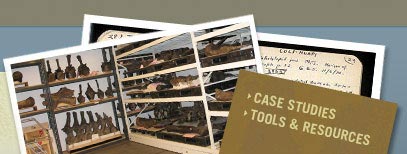Types of Acquisitions
How does a museum decide what kinds of fossil specimens to collect? Most institutions have a collections policy that, among other things, sets out some of the basic rules for how and why a new specimen may be acquired.
The policy may stress that efforts should be concentrated on broadening the variety of fossils in a collection or specializing in a certain type of specimen (e.g., vertebrates or invertebrates). A collection policy can limit collecting to only excavated specimens or specify a ceiling on the price paid for specimens that are purchased. The goal of the policy is to make the best use of available resources to create a collection that best meets the aims of the institution. If you are a private collector, you may not need a written policy but it’s a good idea to think about the principles that will guide your collection decision-making. For an example of an acquisition policy click here to view that of the Peabody Museum of Natural History at Yale University.
Whether you are collecting for an institution or yourself, all acquisitions must be legally obtained. Some issues that institutions should consider when acquiring specimens for their collections include:
- Are the specimens relevant to the scope and purposes of the institution’s collections?
- Can the institution provide for the storage, protection, and preservation of the objects under conditions that ensure their availability for institutional purposes and that are generally in keeping with professionally accepted standards?
- Can the objects remain in the collections as long as they retain their physical integrity, their authenticity, and their relevance for the purposes of the institution, or until it is decided that they should be deaccessioned for other purposes?
Private collectors should also consider whether they are in a position to make scientifically important specimens available to other users, over both the short and long term. This is a responsibility that museums typically accept when they acquire material for their collections. While there may be no legal requirement for private collectors to make their specimens accessible, it is generally a good thing for any paleontologist, whether amateur or professional, to promote responsible use of their collections.
You may prefer to keep the specimen for a period of time before formally incorporating it into your collection, so that you can carry out a proper evaluation of its suitability for acquisition. While the specimen is in your possession you are responsible for its care, so it’s generally a good idea to decide on a fixed period, usually no more than six months, within which you will make a decision about its final fate. Once that period has elapsed, you should have decided either to make it part of your collection; to return it to its legal owner; to offer it to another institution; or to dispose of it in some other way.
Special Circumstances for Acquisitions
Under certain circumstances, such as when the material has been acquired from federally-owned land, it may not be possible for an institution to formally accession the material, because the government agency concerned cannot grant title to the museum. Provided that permission to collect the material has been formally granted, documentation has been gathered to support the collection and storage of materials, and agreement has been reached with all relevant parties, an institution can act as a repository for this material, treating it as a long-term loan or acting as caretaker.
For more information on acquisitions and Native American Lands consult 36 CFR 79: Curation of Federally-Owned and Administered Archaeological Collections or Managing Archaeological Collections.
If you are going to evaluate the specimen before acquisition, it’s a good idea to document this by producing a receipt; one copy of this receipt is passed to the donor while the other is kept by the appropriate institutional staff member. This receipt documents the presence of the specimen in the museum but is not a formal registration of the specimen by the museum, or an acceptance of legal ownership or guardianship of the specimen. Copies of any relevant documents that describe the current ownership of the specimen (e.g., collecting permits) should be kept on file, along with the receipt. If the specimen is being obtained from someone else, adequate documentation of legal collection, acquisition, and ownership will be an important factor in making the decision to incorporate the specimen into your collection. To see an example of associated documents, download Yale Peabody Museum’s Temporary Custody Policy and Temporary Custody Receipt Form.
Fossil specimens can be acquired in several ways: by purchase; as a gift; through exchange; or by carrying out field excavations.



